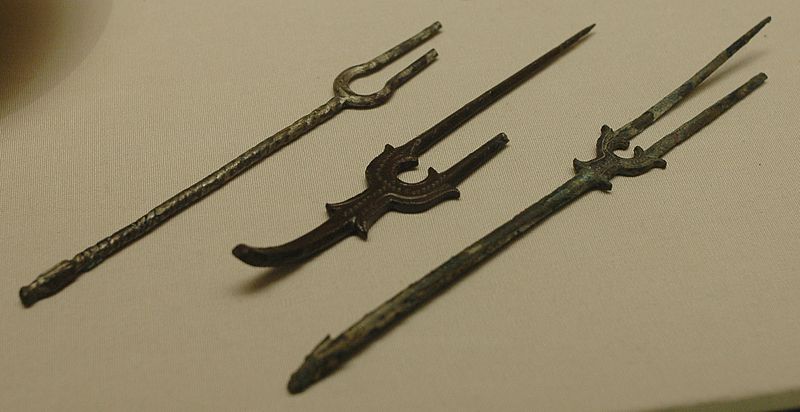Blogs about table place settings are generally instructional by nature. They tell you what to do, where to place different plates and utensils, but not why you should place them there, or why some of these objects exist in the first place. This blog will focus on the why, and that quest for knowledge is going to take us to some surprisingly strange, and sometimes dark, places in history.
Let’s start from oldest to youngest. In part one of this blog we will discuss eating utensils, the utensils evolved first, long before the plates, saucers, cups and glasses we see today. Knives have been used since paleolithic times, as well as spoons. Spoons were made from wood or sea shells, depending on what was available. In fact, the word spoon is derived from the old English word “spon” meaning sliver or splinter of wood. Metal spoons first show up in Ancient Egypt around 1000 BC.
Forks have a more mysterious and sordid past. Large forks were used in cooking meats as far back as the Ancient Egyptians, but small dinner forks didn’t appear until the Middle Ages. Even at that time, fork use was restricted to the Middle East, the Byzantine Empire and into Greece. According to this great article by Chad Ward, they were not seen in Western Europe until the year 10004 when Maria Argyropoulina, Greek niece of Byzantine Emperor Basil II married Giovanni, son of the Pietro Orseolo II, the Doge of Venice.
When Maria moved to Venice, she brought her trusty collection of forks with her. Upon seeing the young bride use the exotic pronged instrument at the feast, members of the clergy were deeply offended. In Europe at the time, most people ate with their hands, just as Jesus and the Apostles had done. Supposedly one member of the clergy wrote “God in his wisdom has provided man with natural forks—his fingers. Therefore it is an insult to him to substitute artificial metal forks for them when eating.” When Maria died of the plaque three years later, it was said by some to be a punishment from god for her vanity.
Despite this supposed divine intervention, forks did gradually catch on in Italy, and it is from there that the utensil spread to the rest of Western Europe. That spread was supposedly jump-started when Cathrine de Medici married the future King Henry II of France. Supposedly she brought forks with her from Italy and soon after they caught on among the elite.
Long after their use spread throughout Europe, forks were still restricted to elite dining tables. Not everyone could afford what was then considered an extra expense for an unnecessary tool. The fork’s lofty position among eating utensils at the time is actually the cause of a divergence of eating etiquette between Americans and Europeans that persists to this day. In the U.S., when you’re using a fork and knife, rules of etiquette demand that you hold the fork in your left hand to hold your food in place, and use your knife in your right, dominant hand to cut. Then you are supposed to put the knife down and switch the fork to you right hand to scoop up the food. That’s how to properly use a knife and fork in the U.S.
In Europe, on the other hand, you keep the fork in you left hand, never switching. According to Ward, this is because forks were not widely available in the Americas during the colonial period, requiring colonists to use their spoon to hold their food when cutting, requiring more force. Also, apparently most knives in the colonies had blunted edges during that time period, due to a law passed in 1669 by Louis XIV of France ordering that all knives e France to be blunted. The law was intended to “cut” down on violent crimes. Being the leaders of fashion that they are, once the French started blunting their knives, everyone else copied them, making dinnertime into an ordeal for American colonists. Imagine trying to slice into a nice steak with a spoon and an blunt knife, it definitely required a little elbow grease!
Interestingly, because both Europeans and Americans use their fork in their left had ( before switching over to the right in the case of Americans) forks are always placed on the left side of the dinner plate.
Speaking about pates, what about plate settings? There’s a surprisingly simple story behind them, but we’ll have to wait until next week to discuss that.










